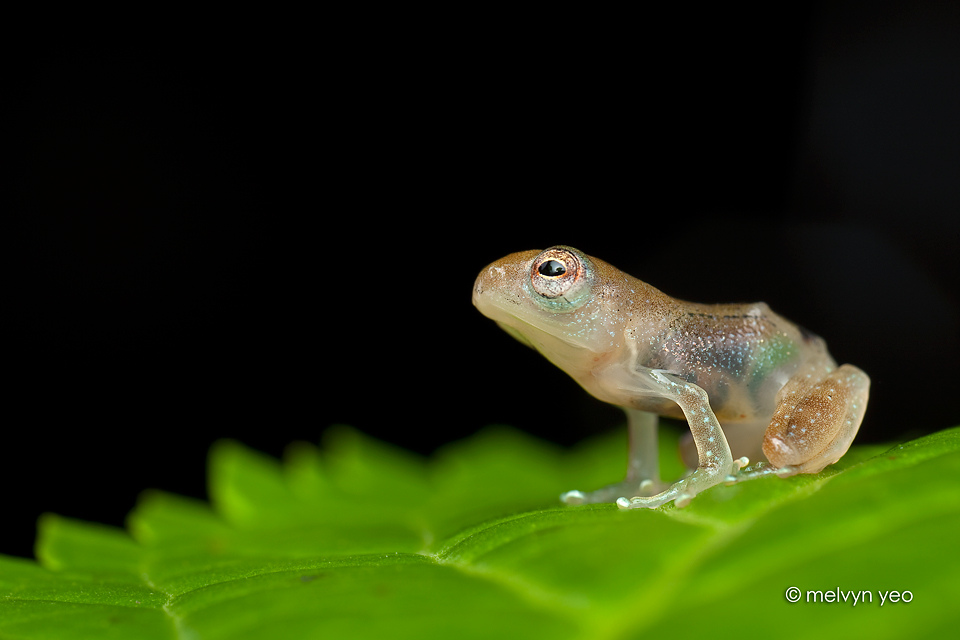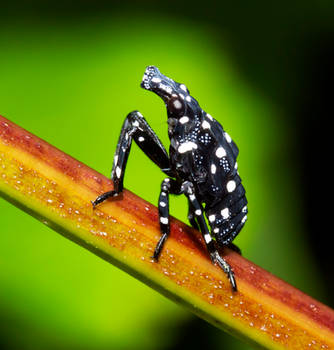ShopDreamUp AI ArtDreamUp
Deviation Actions
Description
Found a beautiful small frog (1cm) with transulcent belly! No id. Taken in Kubah National Park.
Being cold-blooded, frogs have to adopt behaviour patterns to regulate their temperature. To warm up they can move into the sun or onto a warm surface and to cool down they can move into the shade or adopt a stance that exposes the minimum area of skin to the air. This involves squatting down, tucking the forefeet under the chin and the hind feet under the belly. The colour of a frog's skin is used for thermo-regulation. In cool damp conditions the colour will be darker than on a hot dry day. The grey foam-nest tree frog (Chiromantis xerampelina) is even able to turn white to minimize the chance of overheating.
Many frogs are able to absorb water and oxygen directly through the skin, especially around the pelvic area. However, the permeability of a frog's skin can also result in water loss. Glands located all over the body exude mucous which helps keep the skin moist and reduces evaporation. Some glands on the hands and chest of males are specialized to produce sticky secretions to aid in amplexus. Similar glands in tree frogs produce a glue-like substance on the adhesive discs of the feet. Some tree frogs reduce water loss by having a waterproof layer of skin and several South American species coat their skin with a waxy secretion. Others frogs have adopted behaviours to conserve water, including becoming nocturnal and resting in a water-conserving position. This posture involves the frog lying with its toes and fingers tucked under its body and chin with no gap between the body and the substrate. Some frog species will also rest in large groups with each frog pressed against its neighbours. This reduces the amount of skin exposed to the air or a dry surface, and thus reduces water loss. The Woodhouse's Toad (Bufo woodhousii), if given access to water after confinement in a dry location, sits in the shallows to rehydrate itself. These water conservation measures only reduce water loss enough for a predominantly arboreal existence and are not suitable for arid conditions.
Camouflage is a common defensive mechanism in frogs. Most camouflaged frogs are nocturnal, which adds to their ability to hide. Nocturnal frogs usually find the ideal camouflaged position during the day to sleep. Some frogs have the ability to change colour, but this is usually restricted to shades of one or two colours. For example, White's tree frog varies in shades of green and brown. Features such as warts and skin folds are usually found on ground-dwelling frogs, where a smooth skin would not disguise them effectively. Arboreal frogs usually have smooth skin, enabling them to disguise themselves as leaves.
Certain frogs change colour between night and day, as light and moisture stimulate the pigment cells and cause them to expand or contract.
Many frogs contain mild toxins that make them unpalatable to potential predators. For example, all toads have large poison glands—the parotoid glands—located behind the eyes, on the top of the head. Some frogs, such as some poison dart frogs, are especially toxic. The chemical makeup of toxins in frogs varies from irritants to hallucinogens, convulsants, nerve poisons, and vasoconstrictors. Many predators of frogs have adapted to tolerate high levels of these poisons. Others, including humans, may be severely affected.
Oophaga pumilio, a poison dart frog, contains numerous alkaloids which deter predators
Some frogs obtain poisons from the ants and other arthropods they eat; others, such as the Australian Corroboree Frogs (Pseudophryne corroboree and Pseudophryne pengilleyi), can manufacture an alkaloid not derived from their diet. Some native people of South America extract poison from the poison dart frogs and apply it to their darts for hunting, although few species are toxic enough to be used for this purpose. It was previously a misconception the poison was placed on arrows rather than darts. The common name of these frogs was thus changed from "poison arrow frog" to "poison dart frog" in the early 1980s. Poisonous frogs tend to advertise their toxicity with bright colours, an adaptive strategy known as aposematism. There are at least two non-poisonous species of frogs in tropical America (Eleutherodactylus gaigei and Lithodytes lineatus) that mimic the colouration of dart poison frogs' coloration for self-protection (Batesian mimicry).
Because frog toxins are extraordinarily diverse, they have raised the interest of biochemists as a "natural pharmacy". The alkaloid epibatidine, a painkiller 200 times more potent than morphine, is found in some species of poison dart frogs. Other chemicals isolated from the skin of frogs may offer resistance to HIV infection. Arrow and dart poisons are under active investigation for their potential as therapeutic drugs.
The skin secretions of some toads, such as the Colorado River toad and cane toad, contain bufotoxins, some of which, such as bufotenin, are psychoactive, and have therefore been used as recreational drugs. Typically, the skin secretions are dried and smoked. Skin licking is especially dangerous, and appears to constitute an urban myth.
Source [link]
Being cold-blooded, frogs have to adopt behaviour patterns to regulate their temperature. To warm up they can move into the sun or onto a warm surface and to cool down they can move into the shade or adopt a stance that exposes the minimum area of skin to the air. This involves squatting down, tucking the forefeet under the chin and the hind feet under the belly. The colour of a frog's skin is used for thermo-regulation. In cool damp conditions the colour will be darker than on a hot dry day. The grey foam-nest tree frog (Chiromantis xerampelina) is even able to turn white to minimize the chance of overheating.
Many frogs are able to absorb water and oxygen directly through the skin, especially around the pelvic area. However, the permeability of a frog's skin can also result in water loss. Glands located all over the body exude mucous which helps keep the skin moist and reduces evaporation. Some glands on the hands and chest of males are specialized to produce sticky secretions to aid in amplexus. Similar glands in tree frogs produce a glue-like substance on the adhesive discs of the feet. Some tree frogs reduce water loss by having a waterproof layer of skin and several South American species coat their skin with a waxy secretion. Others frogs have adopted behaviours to conserve water, including becoming nocturnal and resting in a water-conserving position. This posture involves the frog lying with its toes and fingers tucked under its body and chin with no gap between the body and the substrate. Some frog species will also rest in large groups with each frog pressed against its neighbours. This reduces the amount of skin exposed to the air or a dry surface, and thus reduces water loss. The Woodhouse's Toad (Bufo woodhousii), if given access to water after confinement in a dry location, sits in the shallows to rehydrate itself. These water conservation measures only reduce water loss enough for a predominantly arboreal existence and are not suitable for arid conditions.
Camouflage is a common defensive mechanism in frogs. Most camouflaged frogs are nocturnal, which adds to their ability to hide. Nocturnal frogs usually find the ideal camouflaged position during the day to sleep. Some frogs have the ability to change colour, but this is usually restricted to shades of one or two colours. For example, White's tree frog varies in shades of green and brown. Features such as warts and skin folds are usually found on ground-dwelling frogs, where a smooth skin would not disguise them effectively. Arboreal frogs usually have smooth skin, enabling them to disguise themselves as leaves.
Certain frogs change colour between night and day, as light and moisture stimulate the pigment cells and cause them to expand or contract.
Many frogs contain mild toxins that make them unpalatable to potential predators. For example, all toads have large poison glands—the parotoid glands—located behind the eyes, on the top of the head. Some frogs, such as some poison dart frogs, are especially toxic. The chemical makeup of toxins in frogs varies from irritants to hallucinogens, convulsants, nerve poisons, and vasoconstrictors. Many predators of frogs have adapted to tolerate high levels of these poisons. Others, including humans, may be severely affected.
Oophaga pumilio, a poison dart frog, contains numerous alkaloids which deter predators
Some frogs obtain poisons from the ants and other arthropods they eat; others, such as the Australian Corroboree Frogs (Pseudophryne corroboree and Pseudophryne pengilleyi), can manufacture an alkaloid not derived from their diet. Some native people of South America extract poison from the poison dart frogs and apply it to their darts for hunting, although few species are toxic enough to be used for this purpose. It was previously a misconception the poison was placed on arrows rather than darts. The common name of these frogs was thus changed from "poison arrow frog" to "poison dart frog" in the early 1980s. Poisonous frogs tend to advertise their toxicity with bright colours, an adaptive strategy known as aposematism. There are at least two non-poisonous species of frogs in tropical America (Eleutherodactylus gaigei and Lithodytes lineatus) that mimic the colouration of dart poison frogs' coloration for self-protection (Batesian mimicry).
Because frog toxins are extraordinarily diverse, they have raised the interest of biochemists as a "natural pharmacy". The alkaloid epibatidine, a painkiller 200 times more potent than morphine, is found in some species of poison dart frogs. Other chemicals isolated from the skin of frogs may offer resistance to HIV infection. Arrow and dart poisons are under active investigation for their potential as therapeutic drugs.
The skin secretions of some toads, such as the Colorado River toad and cane toad, contain bufotoxins, some of which, such as bufotenin, are psychoactive, and have therefore been used as recreational drugs. Typically, the skin secretions are dried and smoked. Skin licking is especially dangerous, and appears to constitute an urban myth.
Source [link]
Image size
960x640px 129.04 KB
© 2012 - 2024 melvynyeo
Comments21
Join the community to add your comment. Already a deviant? Log In
:3 so cute



































